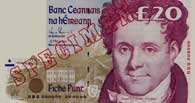
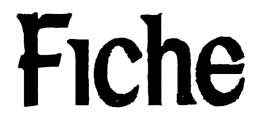
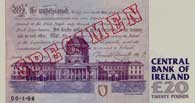
The Central Bank of Ireland Archive, opened to public access in 2017, provided new sources of material on the designs of the Irish Series B banknotes. Some content on this page is based on information from the archive. This is referenced as CBIAR in the text.
The theme of the Series C O'Connell Irish 20 pound note is Irish Politics in the early 19th century. On the right hand side is a large portrait of Daniel O'Connell, who was an important 19th century Irish politician and statesman. Other elements of the banknote's design reflect O'Connell's political achievements.
The Daniel O'Connell 20 Pound note entered circulation on 6 November 1992, some six weeks after the first standard issue date of issue, 21.09.92, and eight weeks after the first replacement note issue date, 10.9.92.
It was the first denomination of the new Series C Central Bank of Ireland Legal Tender Notes to enter circulation.
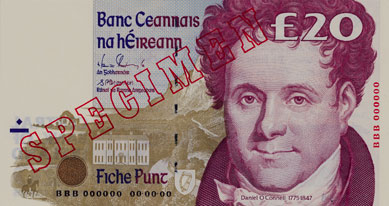
![]()
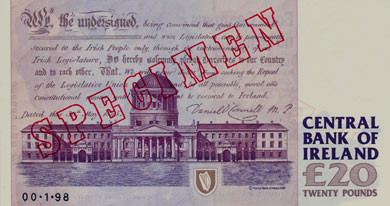
Banknotes of this date are thought to be a probable trial of the new banknote printing process.
This date was printed only as a BBB replacement note, with a likely printage of 60,000 notes for the date in total. As such, with most other dates of Series C O’Connell 20 Pound notes having millions of notes printed, usually 12 million per date, the new Series C banknotes started out with a very rare date.
It is also considered that the date 10 September, the first day and month used on the Lavery Series A banknotes, was chosen deliberately rather than at random for this probable trial run. Numbering the notes as replacements enabled them to be easily issued with standard issue notes of the first print run
BBB replacement notes dated 10.09.92 were first reported a few days after the new £20 notes entered circulation. A nice surprise from the Central Bank for banknote collectors.
Replacement notes were also printed with the first standard issue date, 21.09.92.
On the face, is the text in Irish 'Banc Ceannais na h-Éireann' (Central Bank of Ireland) 'Nóta dlíthairgthe fiche punt' (Legal tender note twenty pounds). Below the signatures are the titles of the signatories in Irish: 'an gobharnóir' (governor) and 'rúnaí na roinne airgeadais' (secretary of the department of finance).
On the right is a prominent portrait of Daniel O'Connell (1775-1847) [2.], Irish politician and statesman. The portrait is based on a mezzotint [3.] by John Gubbins [4.] which was acquired by the National Library of Ireland in 1898.
In the background is a view of Derrynane Abbey in co Kerry [5.], now called Derrynane House, which was the home of O'Connell. This view is taken from a contemporary drawing which is in the National library [6.]. Microprinting of '£20' repeated is on the house and its immediate surrounds.
The latent image security feature, which shows the letters 'IR' when tilted to the light is printed as a brown disc on the bottom left of the face of the note. Microprinting of 'BANCCEANNAISNAHEIREANN' repeated surrounds this security feature.
On the reverse is a drawing of the Four Courts building in Dublin [7.], designed by James Gandon [8.] and completed in 1802. This drawing is based on an original held in the National Library.
Above the building is a pledge signed by Daniel O'Connell and others, dated 30 May 1845, that they will 'never desist from seeking the repeal of the Legislative Union with England'. The original of which is in the National Library [9.].
The £20 note is the lowest denomination to feature microprinting on the reverse in addition to the face. On the top left below the text 'We, the undersigned' are two horizontal parallel lines with microprinting between them of 'CENTRALBANKOFIRELANDTWENTYPOUNDS' repeated.
The O'Connell Twenty Pound note was much smaller than the Series B Yeats Twenty Pound note which it replaced, in common with the other denominations of Series C banknotes.
The dimensions listed are from measurements of actual notes.
Series B, W. B. Yeats 20 Pound Note, 172 x 90 mm.
Series C, Daniel O'Connell 20 Pound Note, 136 x 72 mm.
Below is illustrated the final date of the Series C Irish 20 pound notes.

Series C banknotes were known as the 'Irish Punt series', due likely to being printed only in Irish on the face. The O'Connell '20 Punt' was very common in circulation in the 1990s, and were distributed through the ATM network in vast quantities.
An example of a late date in 1999 of the note is easy to obtain in strict UNC grade with all four corners still sharp (grade 67 with quality mark or higher). UNC examples of earlier dates in strict UNC are much scarcer, and dates in the early 1990s are much more difficult to obtain.
The only date of issue which is not known in UNC is the rare first date, 10.09.92. One GEF is known alsong with several GVF-EF examples. The note is rare in any grade.
All other dates are readily available in circulated grades.
Face and reverse, primarily purple on blue and grey underprint. Black and red serial numbers.
Metallic Thread: A stardust security thread runs through the face of the banknote. This thread also had the denomination in numerals, '£20' repeated throughout its length.
Certain areas of the face of the £20 note flouresce when exposed to UV light. This includes the date and both serial numbers.
The O'Connell 20 pound note was the first denomination of Series C banknotes to enter circulation. It circulated for 10 years, the longest period of circulation of any Series C note.
A lot of well produced forgeries of the Series B £20 note were being passed by the late 1980s. This may have influenced the decision by the Central Bank to replace the £20 denomination first with the new Series C notes which had stronger security features.
E159. Type 20: Signatures: Maurice Doyle, S. P. Cromien. 12 Dates, 7 replacements. 10.09.92-29.04.94.
E160. Type 21: Signatures: Muiris S. Ó Conaill, P. Mullarkey. 13 Dates, 6 replacements. 14.06.95-02.09.97.
E161. Type 22: Signatures: Muiris S. Ó Conaill, P. Mullarkey. Serial prefixing system altered. 11 Dates, 4 replacements. 23.09.97-09.12.99.
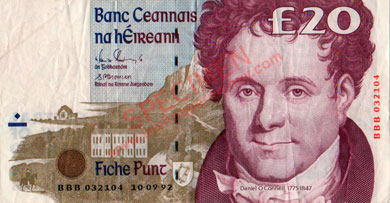
Central Bank of Ireland 20 Pounds, Daniel O'Connell. Doyle, Cromien signatures, 1992-1994
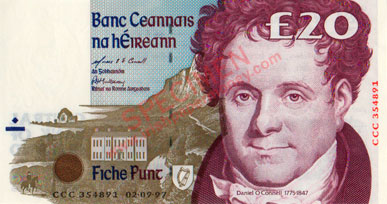
Central Bank of Ireland 20 Pounds, Daniel O'Connell. Ó Conaill, Mullarkey signatures, 1995-1999
There were 36 dates of issue for the Series C O'Connell £20 note. The first date issued was 10.09.92, and the final date was 09.12.99.
Images of all 36 dates of issue can be viewed in the Series C Twenty Pound Note Dates gallery.
O'Connell £20 replacement notes were printed using four sets of prefixes.
References [Last retrieved 04.08.24]
1. Central Bank of Ireland Archives, Dublin. Referred to as CBIAR in the text. [Accessed 24 May 2018].
2. Daniel O'Connell (1775-1847). <https://www.dib.ie/index.php/biography/oconnell-daniel-a6555>
<https://www.clarelibrary.ie/eolas/coclare/people/daniel.htm>
3. O'Connell portrait. <http://onlinecollection.nationalgallery.ie/objects/1157/portrait-of-daniel-oconnell-mp-17751847-statesman>
4. John Gubbins, portrait painter. <https://www.libraryireland.com/irishartists/john-gubbins.php>
5. Derrynane Abbey in co Kerry. <https://www.derrynanehouse.ie>
6. http://onlinecollection.nationalgallery.ie/objects/2092/derrynane-abbey-county-kerry-home-of-daniel-oconnell-mp
7. Four Courts building in Dublin. <https://www.courts.ie/four-courts>
8. James Gandon. <https://www.dib.ie/index.php/biography/gandon-james-a3418>
<https://www.courts.ie/james-gandon>
9. NLI-Historical-Documents-Pack-Daniel-OConnell.compressed.pdf <https://web.archive.org/web/20160703053138/https://www.derrynanehouse.ie/wp-content/uploads/2015/10/NLI-Historical-Documents-Pack-Daniel-OConnell.compressed.pdf>
Background Reading
1. Daniel O'Connell. <https://www.nationalgalleries.org/art-and-artists/38369/daniel-oconnell-1775-1847-irish-nationalist-leader>
<https://www.derrynanehouse.ie/wp-content/uploads/2015/10/NLI-Historical-Documents-Pack-Daniel-OConnell.compressed.pdf>
1 Pound Ploughman
5 Pounds Ploughman
10 Pounds Ploughman
20 Pounds Ploughman
50 Pounds Ploughman
100 Pounds Ploughman
Irish Ten Shilling Notes
1 Pound Note Lady Lavery
5 Pounds Lady Lavery
10 Pounds Lady Lavery
20 Pounds Lady Lavery
50 Pounds Lady Lavery
100 Pounds Lady Lavery
1 Pound Note, Queen Medb
5 Pound Note, John Scotus Eriugena
10 Pound Note, Jonathan Swift
20 Pound Note, W. B. Yeats
50 Pound Note, Turlough O'Carolan
100 Pound Note, Grace O'Malley
5 Pound Note, Sister Catherine McAuley
10 Pound Note, James Joyce
20 Pound Note, Daniel O'Connell
50 Pound Note, Douglas Hyde
100 Pound Note, Charles Stewart Parnell
Northen Ireland Polymer notes
Bank of Ireland Polymer Notes
Danske Bank Polymer Notes
Ulster Bank Polymer Notes
Special Sections and Articles
The Transition of Irish Currency, Irish banknotes 1918–1928
The Partition of Irish Currency, Irish banknotes 1928–1930
Banknote Design Evolution 1824 to 1916
Irish Three Pound Notes
Contemporary Forgeries of Early Irish Banknotes, ca1800-1930
Limerick Soviet Notes
Irish World War 2 Banknote Issues
Low Number Irish Banknotes
Irish Joint Stock Banks of Note Issue from 1783
Irish Legal Tender Note Specimens
Ploughman Scan Survey (PSS)
![]() Stable version. Last update 04.08.24.
Stable version. Last update 04.08.24.